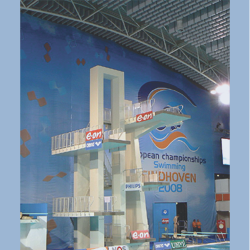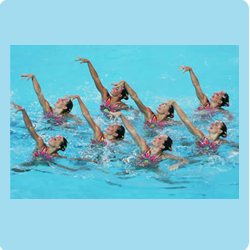 |
 |
Water Polo |
||
Water polo is a team water sport. The game consists of 4 quarters (or periods) in which the two teams attempt to score goals by throwing the ball into their opponent's goal, with the team with the most goals at the end of the game winning the match. A team consists of 6 field players and one goalkeeper in the water at any one time. In addition to this, teams may have substitute field players and one substitute goalkeeper who are not in the water. Water polo is typically played in an all-deep pool (usually at least 1.8m deep or 5.9 feet), and players require stamina and endurance to play the game. Water polo is a contact sport. Minor fouls occur frequently and exclusion fouls (in which a player is suspended from the game for 20 seconds) are common. Special equipment for water polo includes a water polo ball, which floats on the water; numbered and colored caps; and goals, which either float in the water or are attached to the side of the pool. The game consists of swimming (with and without the ball), using a special form of treading water known as the eggbeater kick , throwing, catching, and shooting the ball. All this must be done using a single hand. Each team consists of 6 field players and a goalkeeper. Except for the goalkeeper, players participate in both offensive and defensive roles. The players are also required to have some ability to play in all offensive and defensive roles. The game is thought to have originated in Scotland in the late 19th century as a sort of "water rugby". William Wilson is thought to have developed the game during a similar period. The game thus developed with the formation of the London Water Polo League and has since expanded, becoming widely popular in various places around the world, notably mainland Europe, the United States of America, China, Canada and Australia. |
|
|
Diving |
||
Diving is the sport of jumping or falling into water from a platform or springboard, sometimes while performing acrobatics. Diving is an internationally recognized sport that is part of the Olympic Games. In addition, unstructured and non-competitive diving is a recreational pastime. Diving is one of the most popular Olympic sports with spectators. Competitors possess many of the same characteristics as gymnasts and dancers, including strength, flexibility, kina esthetic judgment and air awareness. Some professional divers were originally gymnasts or dancers as both the sports have similar characteristics to diving. |
 |
|
Synchronized |
||
Synchronized swimming is a hybrid form of swimming, dance and gymnastics, consisting of swimmers (either solos, duets, trios, combos, or teams) performing a synchronized routine of elaborate moves in the water, accompanied by music. Although solos are not used in the Olympics, athletes can perform solos and compete in most other competitions. A recent addition to the Olympic repertoire is the event of mixed pairs, allowing men to compete with a female duet partner. Synchronized swimming demands advanced water skills, and requires great strength, endurance, flexibility, grace, artistry and precise timing, as well as exceptional breath control when upside down underwater. During lifts, (where up to six people act as the platform, one person acts as a base, and one and/or two people act as flyers) swimmers are required not to touch the bottom - yet pull off an outstanding lift. Aside from the new mixed-pair event, Olympic and World Championship competition is not open to men, but other international and national competitions allow male competitors in every event. Both USA Synchro and Synchro Canada allow men to compete with women. – Most European countries allow men to compete also, France even allows male only podiums, according to the number of participants. In the past decade more men are becoming involved in the sport and a global biannual competition called Men's Cup has been steadily growing. Competitors show off their strength, flexibility, and aerobic endurance required to perform difficult routines. Swimmers perform two routines for the judges, one technical and one free, as well as age group routines and figures. Synchronized swimming is both an individual and team sport. Swimmers compete individually during figures, and then as a team during the routine. Figures are made up of a combination of skills and positions that often require control, strength, and flexibility. Swimmers are ranked individually for this part of the competition. The routine involves teamwork and synchronization. It is choreographed to music and often has a theme. |
 |
|
Swimming |
||
The recreational activity of swimming has been recorded since prehistoric times. The earliest recording of swimming dates back to Stone Age paintings from around 10000 years ago. Written references date from 2000 BC. Some of the earliest references to swimming include the Iliad, the Odyssey, the Bible, Beowulf, The Quran along with others. In 1538, Nikolaus Wynmann, a German professor of languages, wrote the first swimming book, The Swimmer or A Dialogue on the Art of Swimming (Der Schwimmer oder ein Zweigespräch über die Schwimmkunst). Swimming emerged as a competitive recreational activity in the 1830s in England. In 1828, the first indoor swimming pool, St George's Baths was opened to the public.[1] By 1837, the National Swimming Society was holding regular swimming competitions in six artificial swimming pools, built around London. The recreational activity grew in popularity and by 1880, when the first national governing body, the Amateur Swimming Association, was formed, there were already over 300 regional clubs in operation across the country. In 1844 two Native American participants at a swimming competition in London introduced the front crawl to a Western audience. Sir John Arthur Trudgen picked up the hand-over stroke from some South American natives and successfully debuted the new stroke in 1873, winning a local competition in England. His stroke is still regarded as the most powerful to use today. Captain Matthew Webb was the first man to swim the English Channel (between England and France), in 1875. He used breaststroke, swimming 21.26 miles (34.21 km) in 21 hours and 45 minutes. His feat was not replicated or surpassed for the next 36 years, until T.W. Burgess made the crossing in 1911. Other European countries also established swimming federations; Germany in 1882, France in 1890 and Hungary in 1896. The first European amateur swimming competitions were in 1889 in Vienna. The world's first women's swimming championship was held in Scotland in 1892. Swimming became part of the first modern Olympic Games in 1896 in Athens. In 1902, the Australian Richmond Cavill introduced the front crawl to the Western world. In 1908, the world swimming association, Fédération Internationale de Natation (FINA), was formed. Butterfly was developed in the 1930s and was at first a variant of breaststroke, until it was accepted as a separate style in 1952. |
 |
Copyright © 2015 - All Rights Reserved - www.bdswimming.org
Web Developed by Bangla Soft IT (+88 01815 26 96 59)